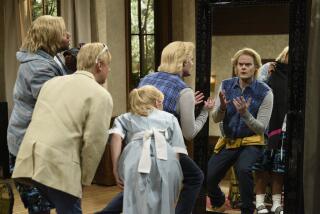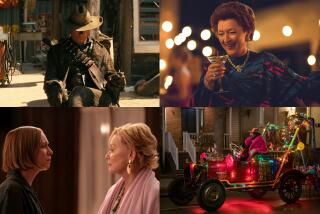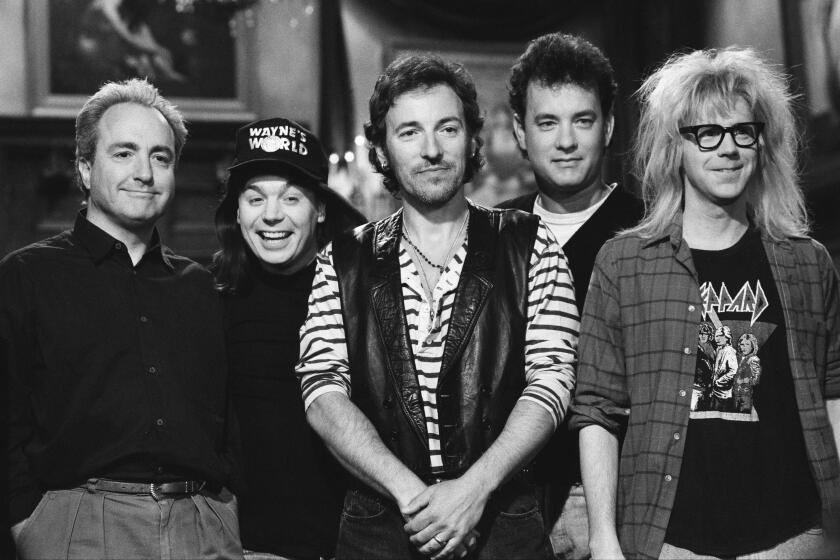GLUED TO THE SET: The 60 Television Shows and Events That Made Us Who We Are Today.<i> By Steven D. Stark</i> .<i> The Free Press: 340 pp., $25</i> : WITHIN THE CONTEXT OF NO CONTEXT.<i> By George W.S. Trow</i> .<i> Atlantic Monthly Press: 119 pp., $20 cloth, $11 paperback</i>
- Share via
Seventeen years ago, the New Yorker published a strange, elliptical essay by George W. S. Trow titled “Within the Context of No Context.” It characterized television as “the force of no-history” and suggested, in almost absurdly alarmist terms, that the electronic box was doing bad things: creating false intimacy, infantilizing grown-ups and blurring the distinction between the trivial and the powerful. “No good can come of it,” Trow harrumphed.
What struck me, however, when I reread the essay in its newly issued book form, was its prediction: “The lie of television has been that there are contexts to which television will grant an access. Since lies last, usually, no more than one generation, television will reform around the idea that television itself is a context to which television will grant an access.”
Almost on cue, one generation after broadcasting’s birth, Steven D. Stark has appeared with a book that argues precisely Trow’s point but without Trow’s elitist grousing. Television, says Stark, a pop culture commentator for National Public Radio, is indeed its own context. How could a revolutionary medium permitting immense crowds of diverse people to share identical experiences be anything but? Nor is it a monolith that has shaped our consciousness but individual programs, a group of which he examines in “Glued to the Set: The 60 Television Shows and Events That Made Us Who We Are Today.”
With this list, Stark has built a solid armature on which to hang all manner of interesting commentary. “Glued to the Set,” however, fails to live up to its promise. Except for a few isolated chapters, mostly involving shows from the late 1980s and early 1990s, Stark seems to lack a point of view. When, for example, he discusses events from the early days of TV, one senses that he has read about them and felt he ought to include them but hasn’t quite figured out where they fit in a larger scheme. Quoting an MIT professor, he criticizes “Dragnet” for its “arthritically pompous camera” that is “so worshipful toward buildings and representatives of official authority that it hardly moves.” Yet Stark’s own account of TV’s first years is afflicted with the same fawning rigidity.
This is frustrating because when Stark does have ideas, he expresses them forcefully. His thoughts on “Roseanne,” for example, are both insightful and fresh. Far from gaining fans as a working-class hero, Roseanne saw her career take off because she was willing to say things that no one else would, like owning up to the hostility parents feel toward their kids. “Why are you so mean?” her TV child asks her at one point. “Because I hate kids and I’m not your real Mom,” she replies. Stark points out that the child-bashing by Roseanne the character seemed to intensify during the notorious child abuse trial of Joel Steinberg and his battered consort, Hedda Nussbaum. “The Steinbergs only did what Roseanne claimed every week she’d like to do herself, ha-ha,” Stark writes, an observation that is as queasy-making as it is accurate. The show “wasn’t popular because it was revolutionary,” he concludes. “It was popular because it was revolting.”
Stark also reveals how child abuse has become a running gag on “America’s Funniest Home Videos,” most of which involve youngsters crashing their bikes into telephone poles, falling or otherwise getting hurt. He also shines on the unlikely topic of “Mr. Ed,” arguing that the talking horse with the shaggy mane was, in fact, a stand-in for a rebellious adolescent. Thus the program attempted to depict the relationship between a traditional father and his son.
Many shows from the 1960s, he suggests, can be studied for their concealed content. “Bewitched,” the story about a conventional housewife who had supernatural talents, was an early attempt to deal with women’s “empowerment,” and “My Favorite Martian,” a story about an alien who looked just like “us,” was really about racism.
Stark fares less well with the shows of the 1970s, when themes like women’s independence were no longer veiled. With “The Mary Tyler Moore Show”--my childhood favorite--he reverts to a slothful habit of paraphrasing others instead of doing original analysis. Worse, he gets facts wrong. To my mind, the show’s greatest episode was “Chuckles Bites the Dust,” a brilliant piece by writer David Lloyd that shows how humor can be used to cope with grief, a theme Peter DeVries explored in his novel “The Blood of the Lamb.”
While dressed as a peanut, Chuckles the Clown, star of a kids’ program at the station where Mary produces the news, is crushed to death by an elephant in a circus parade. To deal with their shock, the newsroom staff makes countless bad jokes, at which Mary takes umbrage--until Chuckles’ funeral, that is, when Mary finally breaks down and laughs uncontrollably.
Stark has clearly heard about this episode and knows that others consider it important. But he calls it the “Chuckles the Clown” show and misidentifies Mary’s close colleague as a “circus performer.” The world will not, of course, spin off its axis because Stark misquoted a title or misidentified a character. But it makes me distrust what he says about shows I know less well.
In another chapter, Stark gets into a swivet about the degenerate quality of local news broadcasts. Yet he ignores the fact that Mary and her fellow characters were satirizing the production of just such a degraded show. Whether accidental or deliberate, this failure to note a link recalls Trow’s “context of no context.”
Lawrence Welk also gets short shrift in “Glued to the Set.” Having had in elementary school a baby sitter addicted to “the Champagne Music Man,” I remember being fascinated by the way Welk’s attachment to fecund female performers (at least one Lennon Sister seemed to be pregnant at all times) was matched by a phobia about showing pregnancy on television. This forced Welk to hide these women in increasingly inventive fashions, behind a piano or some bizarre prop, like an oversize Halloween pumpkin.
Stark correctly observes that Lawrence Welk was among the first to reveal the vast schism that developed in the ‘60s between “urban coastal culture” and the “more-populous ‘other America.’ ” But I wish he’d given the reader a sense of what happened on the show.
To a degree, the problem lies in Stark’s writing. Although it is blessedly free of postmodern jargon, it is not without irritating tics. He will often take apart paragraphs and bullet key points, the sort of thing one expects in an eighth-grade science textbook, not in a serious essay.
He also has a lazy way of making controversial assertions in language that implies no one would challenge them. “You don’t have to be a disciple of Carol Gilligan or Deborah Tannen to know women express themselves differently than men,” he writes. (I wouldn’t be so sure.) Or, “You don’t have to be a Trekkie to know that the original series premiered on Sept. 8, 1966, and was promptly panned by Variety as an ‘incredible and dreary mess.’ ” (I had no idea.) At his most annoying, he combines bulleted sentences with a “You don’t have to be” construction. Point 1: Oprah is “the most celebrated and powerful black woman in U.S. history.” Point 2: She is the “undisputed leader of a television genre” that has been attacked by “the establishment.” Then: “You don’t have to be an Albert Einstein to recognize that these two propositions are related.”
I wish Stark hadn’t had the ambition to produce a definitive volume and could have simply charted his fixations. He seems, for instance, to be obsessed with actor Michael Landon--the former Eugene Maurice Orowitz--and more than once manages to work in some quirky reference to him. Better, I think, that Stark had written at length about Landon and left, say, TV’s coverage of the space program to someone who seemed to care about it.
With the advent of cable--and its vast smorgasbord of choices--viewers today are no longer shaped by a handful of shared experiences. This perhaps heightens the need for a book that comments on the period when they were. Instead of a volume by a single pundit, I’d like to see strong offbeat essays by a bunch of analysts who have actually watched the broadcasts they’re discussing. In recognition of TV’s self-referential-ity, it might be revealing to hear TV writers reflect on the shows that made them what they are. I am not exactly sure what or whom such a book would include, but I do have a working title: “In Its Own Context.”
More to Read
Sign up for our Book Club newsletter
Get the latest news, events and more from the Los Angeles Times Book Club, and help us get L.A. reading and talking.
You may occasionally receive promotional content from the Los Angeles Times.









